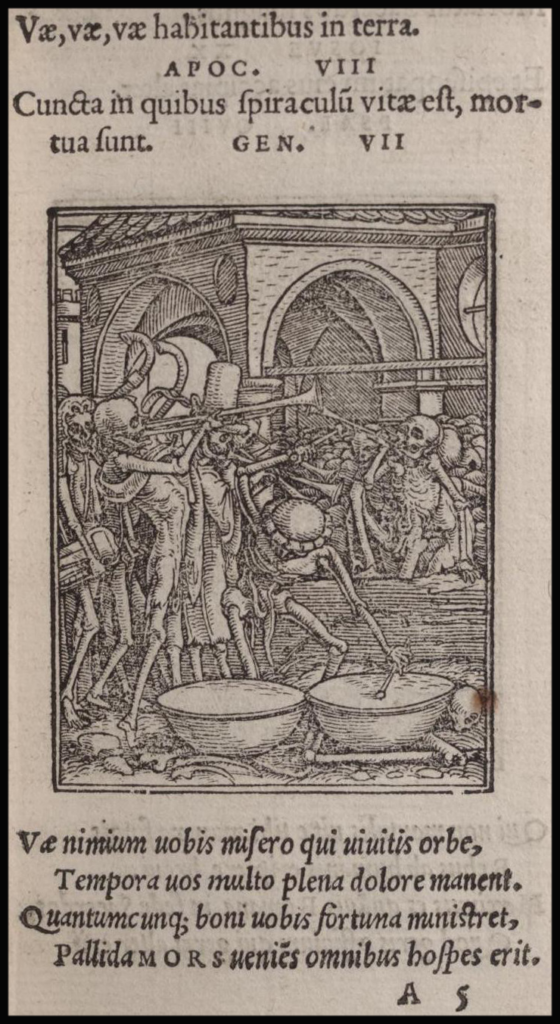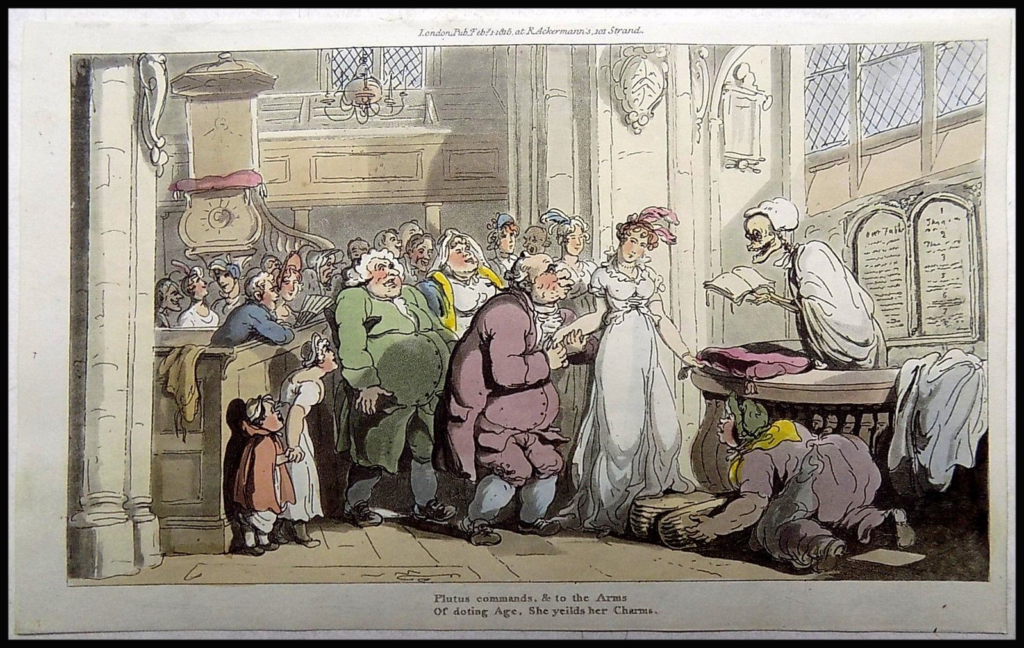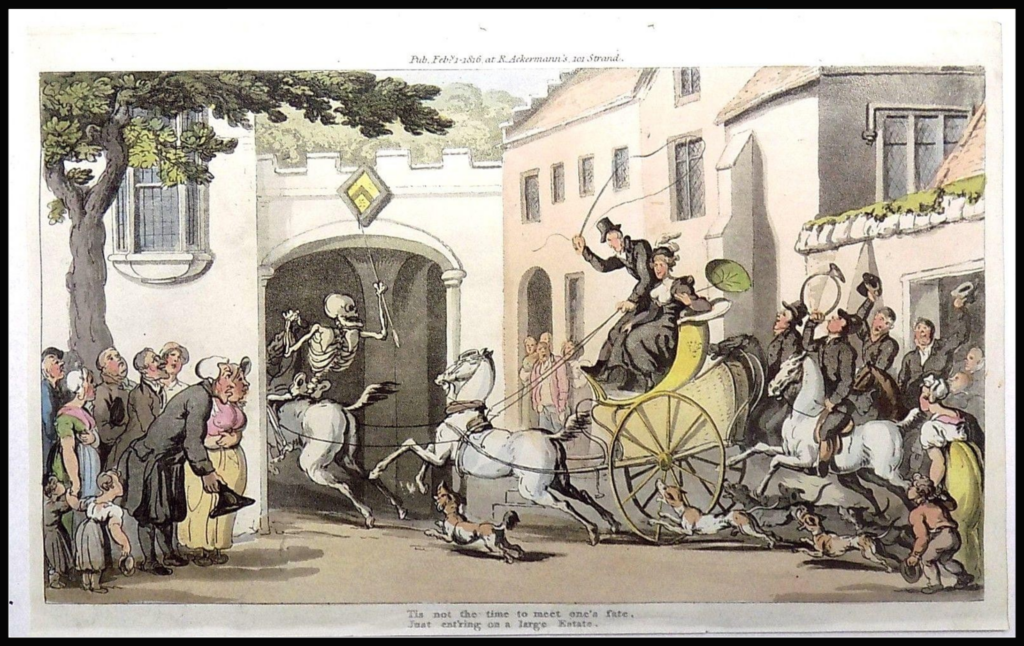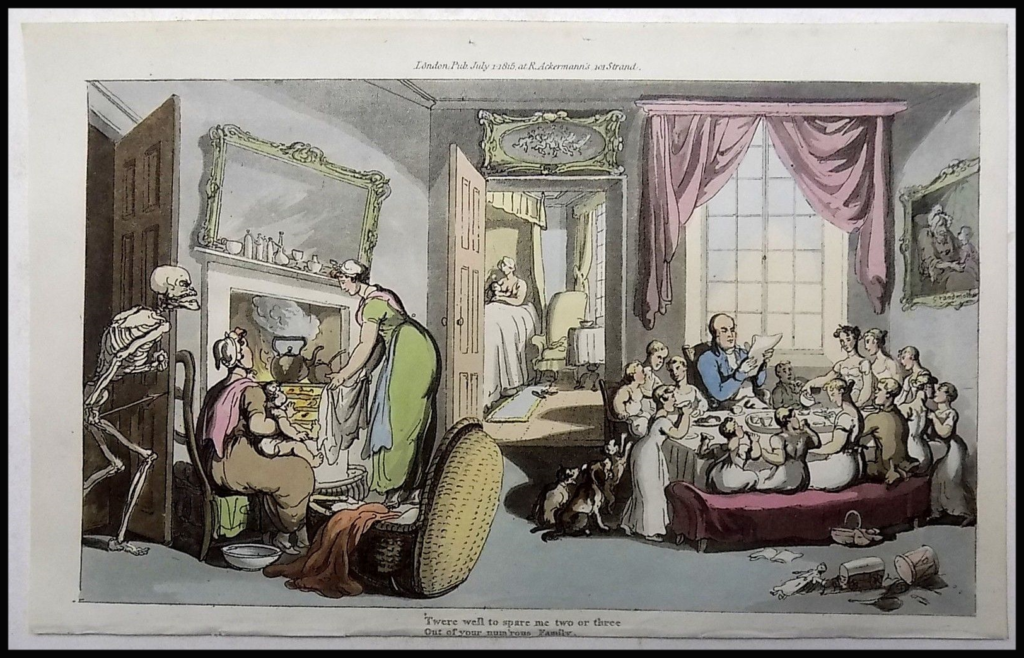Thomas Rowlandson (1756–1827) was a prolific English artist known for political and satirical prints. Much of his art was in the form of engravings and etching that were then printed individually or in collections. Because these prints could be inexpensively produced his art was available to the general public. Rowlandson was often censured, as much for his biting social commentary on the powerful of the day, as the bawdy caricatures of their private and public life. Rowlandson’s art is distinctive in its style and was copied by many others in the newspapers and gazettes in Europe and America.
The subject of The Dance of Death finds its origin in the Late Middle Age allegory of the Danse Macabre. Whether this genre developed because of the horrors of the Black Death, or the deprivations and unending wars of feudal Europe, it became a popular subject expressed in art, dance, and song. Some of the earliest recorded depictions of The Dance were murals painted on the walls of charnel houses of Paris in the 1420’s. While dancing was an important part of the iconography of this genre, dancing was not always portrayed in the art work. These early depictions show lines of people from Pope to Pauper being led by skeletons to their death. Death was the great leveler of the time.
The Dance appeared in the Liber Chronicarum (Book of Chronicles), often known as the Nuremberg Chronicle, printed in 1492. Draped with shrouds the skeletons appear to be quite festive. The everyday presence of death was so prevalent that even the children’s rhyme Ring Around the Rosie has been attributed to memories of the plague. With the advent of the printing press The Dance was represented in many books, pamphlets and prints.
Hans Holbein the Younger created one of the best-known series of The Dance during the period of 1523 to 1526. Death comes in many disguises and no one escapes the skeletal hand. Sold individually and in book form his prints were extremely popular.
Now back to Thomas Rowlandson. Following in the tradition of The Dance, and echoing the morality prints of William Hogarth, Rowlandson created a series of prints collected together in the two-volume set The English Dance of Death. The English Dance of Death was originally issued in twenty-four monthly subscriptions. Published between 1814-16 the cartoons were accompanied by verses, written by the comic poet William Combe under the pen name Doctor Syntax. Again, Rowlandson presents Death as the universal marauder, stretching out his bony hand to clutch at his prey at in the most unexpected and inopportune occasion. Rowlandson shows us the vanity of human life and the futility of human pleasures and pursuits
Plutus commands. & to the Arms
of doting Age, She yields her Charms.
There is a proverb that is known
By ev’ry lively Miss in Town,
For whom Love lies in ambuscade,
— That Marriages in Heaven are made.
Thus, when the Fair, resolv’d to wed,
Receives the Captain to her bed,
Whose only fortune is his pay
Of nothing like a pound per day,
A father’s anger to assuage,
And calm an humbled Mother’s rage,
She says, in hopes to be forgiven,
The nuptial knot was tied in Heaven.
How could she help it — when her Love
Was govern’d by the powers above ;
And therefore would Papa persuade
That this same match was wisely made ;
Nay, asks the Dower he would accord,
As if her Spouse had been a Lord.
— But ’tis not Birth, nor is it gold
That does the sacred Union hold.
There is a not so subtle hint that the marriage is not for love:
But ’tis not form’d by Nature’s plan
To give such Happiness to Man :
It would be folly then to wonder
That Love and Plutus keep asunder ;
For Hymen ‘s ever at their will
Their sep’rate pleasure to fulfil ;
Though Plutus seems to take the lead
Of Love, in matrimonial deed :
Such is, at least, the gen’ral creed : —
And such Amelia’s tale will prove
Who married Wealth, nor thought of Love.
Tis not the time to meet one’s fate.
Just ent’ring on a large Estate.
What sudden changes do we see,
What wonderful Variety,
In all that passes here below.
From Grief to Joy, from Joy to Woe !
How oft do the transitions seem
The rapid movements of a dream :
But no where does the change appear
So oft within one fleeting year ;
So oft display the motley mien
As in the pantomimic scene
Which Fashion, by her magic power.
Forms to enliven every hour.
The parable ends with the following:
The Chaise was high, the Gate was low,
His Head receiv’d the fatal blow
From the rude arch ; — He loos’d the rein.
And fell, no more to rise again.
— Thus, as Joy brighten’d Sorrow’s gloom,
He sunk, untimely, to the Tomb.
But ah, those Sorrows did not wait
Upon his unexpected Fate,
Which mourn’d Lord Ronald good and
great.
‘Twere well to spare me two or three
Out of your num’rous Family
Doctor Syntax expounds on the woes of man:
Broken with toils, with arms opprest,
The Soldier thinks the Merchant blest ;
And when the threat’ning Tempests rise,
Arm me for war, the Merchant cries :
While he, who in the City lives.
Sighs for the peace the Country gives ;
The Country Folk unheard, unknown.
Think there ‘s no pleasure but in Town.
But in this tableaux Death has his eye on more, Jemmy Guest’s family:
One morn at breakfast, as He sat,
Attentive to their various chat.
Death at the door in form appear’d ;
And, as aloft his arm he rear’d,
Jemmy began to stir and stare
And ask’d the Shape his errand there.
He grinn’d a ghastly smile, and said —
To follow his old-fashioned trade.
To get a pretty little picking
Among this brood of human chicken.
Jemmy replied — I ’11 ne’er consent
To such a barbarous intent :
Touch not, I pray, a single feather.
Take none, or take us all together.
— Think not, said Death, I ’11 march away
And let my arrow lose its prey :
Why, here ‘s this brat so loudly squalling —
Leave him to me — I ’11 stop his bawling.
— Poor little dear, it scarce can walk.
And has but just begun to talk.
— Then, there’s the Babe in t’ other room,
Who will not talk for months to come.
— If from her Nursling forc’d to part,
T’would break the Angel Mother’s heart.
Indeed I cannot spare you one.
So take us all, or pray be gone.
But if you must employ your dart.
E’er from this chamber you depart.
To me and mine delay the curse,
And make your meal upon the NURSE.
Did death take them all? During this time it was a great possibility.
—–
DLWA Call Number: D11 S32
Worldcat: Link
- Title: Liber Chronicarum (The Nuremberg Chronicle)
- Author: Hartmann Schedel
- Language: Latin
- Setting: book history
DLWA Call Number: PR3359 .C5 E5 1815
Worldcat: Link
- Title: The English dance of death
- Author: Thomas Rowlandson and William Combe
- Language: English
- Setting: Prints, Early Modern Political Satire
—–
-
Pencil sketch portrait of Thomas Rowlandson by George Henry Harlow (d. 1819), currently in the National Portrait Gallery, London.
Date – 1814 - Klein, Augusta Julia, “Death in the City of Light : The Culture of Death in Paris from the Middle Ages through the NineteenthCentury” (2017).Senior Projects Spring 2017. 273
- Schedel, Hartmann, and Anton Koberger. 1493. Liber chronicarum. Nürnberg: Anton Koberger.
- Holbein, Hans, Hans Sebald Beham, François Gryphius, Joannis Bittner, Richard Copley Christie, Ignatius Gunther, Wenceslas Kail, F. Maillard, Tom Webster, and Thomas White. 1542. Biblia, insignium historiarum simulachris, cùm uenustati, tũ ueritati accomodis illustrata. Cætera sequens pagina docebit. [Paris]: Excudebat Fran. Gryphius.
- Rowlandson, Thomas, and William Combe. 1815. The English dance of death. London: Pr. by J. Diggens.
- ibid.
- ibid.
–DLW







